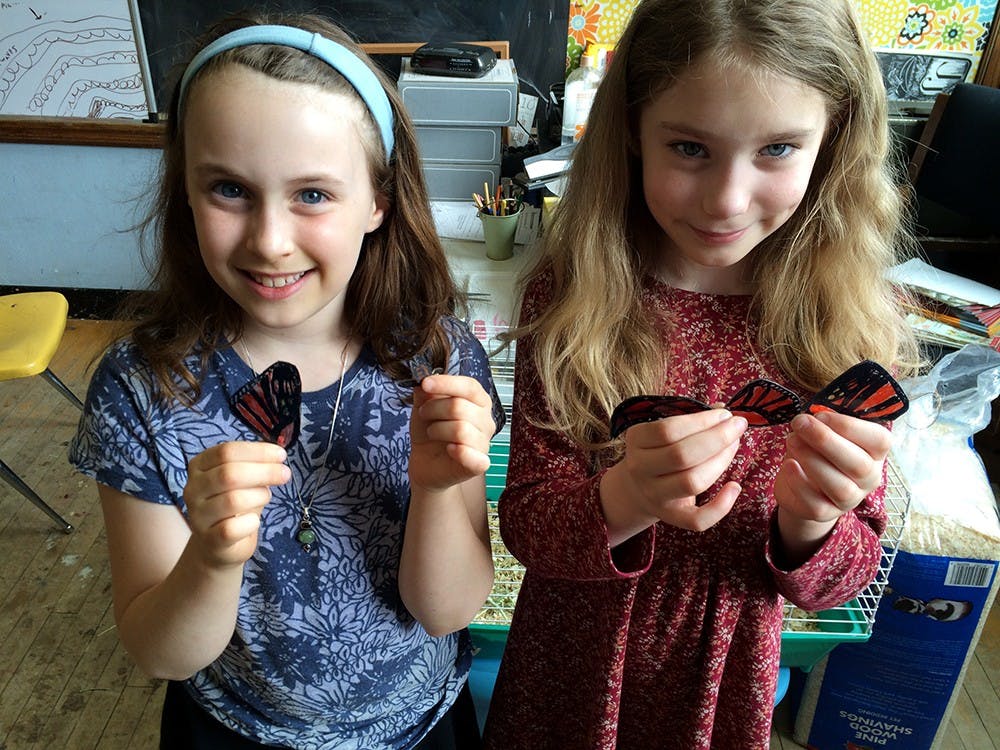“They’re really just smaller versions, but a bit different, of humans,” Casey said. “I think they’re really beautiful.”
Novak emphatically nodded in agreement.
“I’ve always been amazed at how the butterfly barely rests and then flies 3,000 miles to Mexico,” she added, referring to the monarch’s impressive yearly migration from the U.S. down to more temperate forests in Mexico. “They’re so small, and they still survive all of the wind and the rain. Well, some of them survive.”
The girls are fourth graders at Harmony School, and they’ve just completed a mini-elective class called “Save the Monarchs.” During the course, they read books and watched videos about the famous orange and black butterflies. Students also crafted their own monarch models, which will be featured in the “Save the Monarchs” exhibit at the Indianapolis ?Artsgarden.
“It was actually perfect because I’d already had a couple of students who had brought up monarchs and wanted to help,” said Lana Cruce, the girls’ teacher. “We made the butterflies out of recycled number six plastic that we colored, baked and then wired together.”
The exhibit, which will run April 13-May 17, is put on by Earth Charter Indiana and the Arts Council of Indianapolis among others to raise awareness about the decline in the monarch butterfly ?population.
The monarch, which was included in the Endangered Species Coalition’s newest list of “Ten American Species Our Children May Never See,” has experienced a 90-percent drop in population in recent years, caused by climate change, increased use of herbicide-based agriculture and deforestation in Mexico.
“I hate illegal logging,” Casey said, slamming her small fist. “I’m going to write a letter to the mayor about this and maybe ask them to send police to Mexico to stop people from cutting down trees.”
The U.S. Fish and Wildlife Service recently announced the beginning of a yearlong review process to officially classify monarchs as endangered species. This classification would likely result in agricultural restrictions on farmers who use herbicides that are harmful to the monarch’s habitat.
“In my experience of working with kids in schools, when a young person finds out about a problem, like the decline of monarchs, they don’t get caught up in feelings of futility, they just want to solve it,” said Jim Poyser, the executive director of Earth Charter Indiana. “Giving them an art project is a great way to give them something to do, and art’s a great platform to learn about science, and vice versa of course.”
Cruce said she believes the students’ passion could help inspire others to take ?a stand.
“Watching them work on these projects and teach each other about the monarchs really shows the power that kids can have,” she said. “When they get excited about something, they can make the other kids excited in a way that adults never can. It’s a pretty powerful thing.”
These 10-year-olds have ideas of how to save their second favorite animal — they both like cats a little more).
“I personally think that the earlier you’re informed, the better chance you have to save them,” Novak said. “If every school in the world did something to raise awareness then we would definitely be able to keep them alive. But that’s like 18 gazillion, 966 schools.”
“I think college should teach a class about monarchs,” Casey agreed. “And I think it would be better if the class wasn’t optional.”






